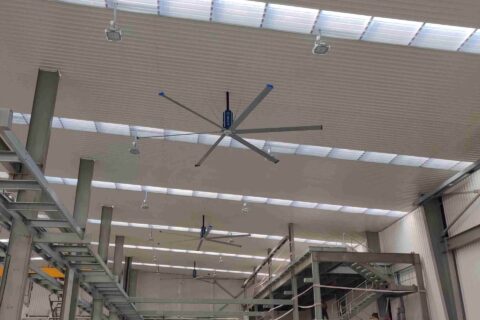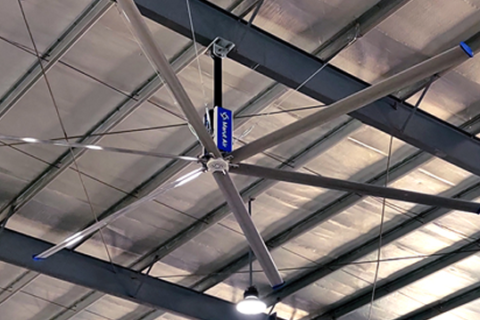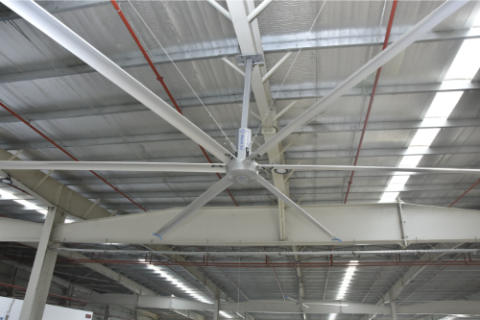When it comes to managing large warehouses, keeping the space comfortable for workers is crucial. One way to do this is by installing high-volume low-speed (HVLS) fans. These fans are designed to move a large volume of air at low speeds, making them ideal for large spaces such as warehouses. Here are some reasons why you should consider installing HVLS fans in your warehouse.
Why Warehouses Need HVLS Fans?
Warehouses require High-Volume Low-Speed (HVLS) fans to promote employee comfort and overall productivity, improve indoor air quality through air movement which removes dust and moisture, realize energy savings by improving the heating/cooling efficiencies through air destratification and reduce the potential of damage to product or equipment. These massive, slow-speed fans create a powerful air movement but in a gentle, non-directional manner ultimately creating a gentle air stream throughout a large space, thus achieving a more uniform, comfortable environment year round.
Benefits Of Installing Hvls Fan For Warehouse
Improved Air Circulation
HVLS fans move a large volume of air throughout the space, creating a comfortable environment for workers. The constant circulation of air also helps improve air quality by reducing stagnant air, which can lead to health issues.
Energy Efficiency
HVLS fans are energy-efficient and can help reduce energy costs. They can be used in conjunction with air conditioning or heating systems to reduce the load on these systems, resulting in significant energy savings.
Productivity
Comfortable workers are more productive workers. By creating a comfortable environment, HVLS fans can improve worker productivity and reduce downtime due to heat stress.
you can also read: What You Need to Know About HVLS Fans and Cooling Power
Safety
HVLS fans can help improve safety in the warehouse by reducing moisture levels, preventing condensation, and minimizing the risk of slip and fall accidents.
Durability
HVLS fans are designed to last for years and require minimal maintenance. They are also built to withstand the harsh environments of warehouses, making them a smart investment.
What are the Key Differences Between HVLS Fans & Other Cooling Methods?
Here are some of the key differences between HVLS fans & cooling methods:
| Aspect | HVLS Fans | Traditional Air Conditioners | Small/Residential Fans |
| Cooling Mechanism | Cools through air movement and evaporation from the skin | Actively lowers air temperature using refrigerants | Provides localized cooling with fast, turbulent airflow |
| Energy Consumption | Highly energy-efficient | High energy consumption, especially in large spaces | Moderate energy use but limited impact on large areas |
| Environment | Eco-friendly, no refrigerants, low carbon footprint | Uses refrigerants and higher environmental impact | No refrigerants, but less efficient for warehouses |
| Area Coverage | Covers large open spaces with uniform airflow | Effective for enclosed spaces but costly for large areas | Limited to small, focused zones |
| Volume & Speed | Moves massive air volume at low speeds | Not applicable; lowers air temp via compressors | Moves small air volume at high speeds |
| Noise Level | Quieter due to slow blade rotation | Noise depends on unit, compressors can be loud | Louder due to high-speed operation |
| Size | Very large (blades 7+ feet in diameter) | Unit size varies; often bulky with ducts/pipes | Small and portable |
| Airflow Pattern | Gentle, laminar airflow across wide areas | Cold air blown directly into space | Focused, turbulent airflow in small radius |
How to Choose the Right HVLS Fan for Your Warehouse?
You should consider several factors when selecting the right HVLS fan for a warehouse:
1. Calculate the Needs of your Space:
- Measure Your Space: To calculate the volume of your warehouse, you should determine its length, width and height.
- Determine Air Changes per Hour (ACH): This is essentially the total number of times the entire volume of air in your warehouse needs to be circulated in one hour. For dry goods, it typically requires 2 to 4 ACH and for food or chemicals, it may require 6 or more ACH.
- Calculate Required CFM: To calculate the total cubic feet per minute (CFM), multiply the volume of your space by the desired ACH and then divide it by 60. (Example: (Space Volume) x (ACH) / 60 = Required CFM)
2. Select the Right Fan
- Fan size and coverage: Larger diameter fans circulate more air and are appropriate for large spaces but will not exceed 24 feet in diameter. If the area is large or contains obstructions, limit larger fans to 24 feet on a non-use basis
- CFM Rating: Select fans whose CFM rating matches the CFM calculated for your warehouse.
- Obstructions: Take note of beams, racks or machinery that may create obstructions and choose a fan size and location that minimizes obstructions wherever it can.
- Motor technology: Look for efficiencies such as high-efficiency brushless EC motors with very little repaint requirement and long-term potential energy savings.
- Environmental handling: If operating in a humid environment use fans with corrosion-resistant materials.
3. Consider Additional Factors
- Noise Levels: HVLS fans are quieter than standard fans; however, some spaces require a quieter fan for general use (logistics areas, gyms, conference rooms, etc.).
- Long-Term Costs: Some energy-efficient fans use less energy per hour but have a higher upfront cost. Long-term, energy-efficient fans will save you over the life cycle of the fan in operating costs.
- Consult a Professional: If your space is complicated or you are unsure, look to a professional fan vendor such as Marut Air, who can provide advanced airflow solutions to meet your warehouse needs.
Conclusion
In conclusion, HVLS fans are an excellent choice for warehouses looking to improve worker comfort, productivity, safety, and energy efficiency. Marut Air is a leading HVLS fan manufacturer in India that offers a range of HVLS fans suitable for various industries, including warehouses. Their fans are designed to provide improved air circulation, energy efficiency, and durability, making them a smart investment for any warehouse.
In addition to HVLS fans, Marut Air also offers HVLS ceiling fans, which are ideal for spaces with high ceilings. These ceiling fans are designed to provide a comfortable environment by circulating a large volume of air at low speeds, reducing the load on air conditioning or heating systems, and improving worker productivity. If you’re looking to install HVLS fans or ceiling fans in your warehouse, consider Marut Air for their high-quality products and excellent customer service.
People Also Ask For HVLS Fan For Warehouse
Question 1. How does an HVLS fan improve worker productivity in warehouses?
Answer. HVLS fans improve worker productivity in warehouses by reducing heat stress, maintaining comfortable temperatures and improving air quality.
Question 2. What is the average lifespan of an HVLS fan?
Answer. HVLS fans can last for many years with proper installation and regular maintenance and are a long-term investment.
Question 3. Can HVLS fans be used in all types of warehouses?
Answer. Yes, HVLS fans are perfect for most warehouses including logistics centers, distribution hubs, manufacturing units and storage facilities.





